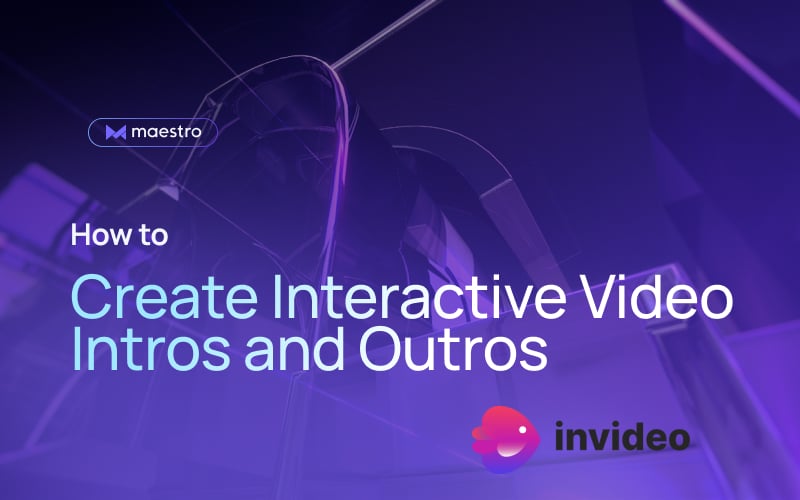How to Create Interactive Video Intros and Outros for an Engaging UX

Did you know that 91% of businesses use video as a marketing tool? With the rise in popularity of video formats, it has become increasingly challenging to stand out.
One of the challenges is that the audience's attention span is dropping at an alarming rate. It’s so important to prioritize intros and outros since are like the entrance and exit doors to your video story, making a lasting impression.
In this guide, we'll dive into the crucial role videos play in viewer retention and satisfaction. From the fundamentals to advanced techniques, we will take you on a journey to master the art of crafting compelling intros and outros that redefine the interactive experience for your users.
This article is a guest post from a video creation expert at invideo AI.
Table of Contents
- Video Intros and Outros: The Basics
- Adding Interactivity to Your Intros and Outros
- The Designer's Guide to Interactive Intros
- The Designer's Guide to Interactive Outros
- Leveraging AI for Enhanced Video Creation
- Common Mistakes to Avoid with Intros and Outros
- Final Thoughts
Video Intros and Outros: The Basics

Whether you're just starting to create video intros and outros or you’re a seasoned veteran, knowing the “why” is the first step to making a good start and end video. Here are a few things you need to know.
1. Explaining Your Unique Value Proposition (USP)
When a new user lands on your video, they will likely have a few questions, including who you are, what you do, and what you have to offer.
On average, it takes 1.5 seconds for a user to decide whether to stay or move on. By making an interesting intro for your video, you can attract their attention and make it easy for them to understand everything.
Remember that unclear signals can be off-putting. Instead, be your audience's friend and guide when they enter a new world.
2. Opportunity for Guiding the Tone
The tone of voice you use sets you apart from everyone else. Depending on the tone of your intro and outro video, your users will instinctively understand what they can expect from you.
For example, if your mission is to solve a problem, you want to use an empathetic yet logical tone. If your mission is to be a knowledge leader, you want to use an explanatory tone.
You should use the same voice in your intro and outro. If you don’t have a voice actor on the payroll, we recommend trying out some natural AI voice generators.
3. Prompt Action
So, you have your users hooked. They love your brand and the content. Then what? An outro video ensures there is a call-to-action (CTA) at the end to prompt users to convert.
In essence, it means that you can guide their next action to contact you, sign up, subscribe, or purchase. It makes the action after the video clear. If that is not present, you stand the chance of the viewers simply moving on.
That's why savvy brands are increasingly leveraging UGC partnership opportunities in their outro messaging. Inviting audiences to create and share their own content provides a seamless transition from passive viewing to active engagement.
Adding Interactivity to Your Intros and Outros
Did you know that about 80% of customers are willing to purchase if their experience is personalized? Interactive videos are the most efficient way of making it possible.
Here are a few things to note about using interactivity in your videos.
1. Hotspots and Overlays
Guide viewers to check out more related content using hotspots and overlays. If you’re unfamiliar, these are clickable spots in the video that are linked to other destinations. They can be text, pictures, buttons to click, maps, or even audio and visual cues – everything you need to guide the user's journey exactly how you want to.
When someone clicks on it, it takes them to another place, like a product page. It's an easy way to make videos interactive and even turn them into something you can shop from.
2. Time Triggers
If you don't want to rely on the viewer clicking or hovering over the video for interactions, use time triggers.
This means you can make things happen in the video at a certain time without the viewer doing anything. The usual idea is to open overlays, which are those extra things like text or pictures that pop up at a specific moment in the video.
3. Branching
Branching is one of the coolest ways to make videos interactive. With this technique, viewers can jump around in the video, kind of like creating their own adventure.
It's like picking different paths in a story based on the choices you make during the video. So, they get to decide how the video goes, and your content has the maximum impact.
The Designer's Guide to Interactive Intros

Now that you understand the “why,” it’s time to get into the “how.” Let’s review some actionable steps for creating interactive video intros.
Define Your Message
Clearly understand what message or information you want to convey in your intro. Identify key points or elements that you want viewers to interact with and the end goal of what success looks like.
Use Invideo's In-Built Templates
Familiarize yourself with Invideo's intro templates, designed to create and edit seamlessly for social media and shopping experiences. From shoppable videos to monetization from live streams, you can plug and play in the world of social commerce with interactive workflows – all without having to code anything!
From shoppable videos to monetization from live streams, you can plug and play your perfect scenario with interactive workflows – all without coding anything!
Craft a Storyboard
In designing an interactive introduction, a storyboard is crucial for planning out your content flow and the placement of interactive elements. Start by outlining the major scenes and how you want to engage your audience.
Each part of your storyboard should detail where and how interactive features like clickable areas or decision points will appear, ensuring they integrate seamlessly with the narrative. This visual plan helps ensure your interactive intro is both engaging and cohesive, guiding viewers through a dynamic experience right from the start.
Explore Branches, Overlays, and Time Triggers
Branching techniques will allow viewers to choose different paths, and you can pre-program it into your intro video. Use time triggers to initiate events in the video without requiring viewer interaction.
The Designer's Guide to Interactive Outros
Now, let’s get into the details of creating interactive video outros.
Define Your Objective
Clarify the goals of your outro. Do you want to encourage further engagement, provide additional resources, or guide viewers to specific actions? What information do you need to include to yield the results you’re looking for?
Craft a Clear Call-to-Action (CTA)
Determine the main action you want viewers to take at the end of the video. Create a compelling CTA that encourages engagement, such as visiting a website, subscribing, or exploring related content.
Leveraging AI for Enhanced Video Creation
In the dynamic field of video production, utilizing advanced AI tools can elevate your interactive content. Explore tools for automated video generation to streamline your workflow, analyze user behavior, optimize content delivery, and personalize the viewing experience. This contributes to increased viewer retention and satisfaction.
Common Mistakes to Avoid with Intros and Outros
When creating interactive videos, it's crucial to steer clear of a few common mistakes to ensure a seamless and engaging viewer experience.
Some pitfalls to avoid include:
- Avoid overwhelming viewers with excessive interactivity
- Thoroughly test the video to identify and fix technical glitches
- Align interactive elements with the video narrative to maintain the flow
- Implement accessibility features for users with disabilities
Final Thoughts
Interactive intros and outros play a crucial role in engaging audiences and driving viewer retention. By leveraging interactive elements like hotspots, overlays, branching, and time triggers, you can craft dynamic video experiences that captivate users.
At the very least, remember to define your key messaging upfront and utilize templates and storyboards to map out interactivity in your intro and outro videos. Focus on clear CTAs in your outro to convert viewers into customers.
About the Author
Ankit Solanki is a tech investor who loves finding promising tech startups and helping them grow. One of his portfolio companies, Invideo, took a risk and offered me a playground to test my skills and expertise in building startups. When I’m not busy growing the company, you’ll find me writing about tech, Artificial Intelligence, growth, and investing – and sometimes, sneaking in a game of soccer.
